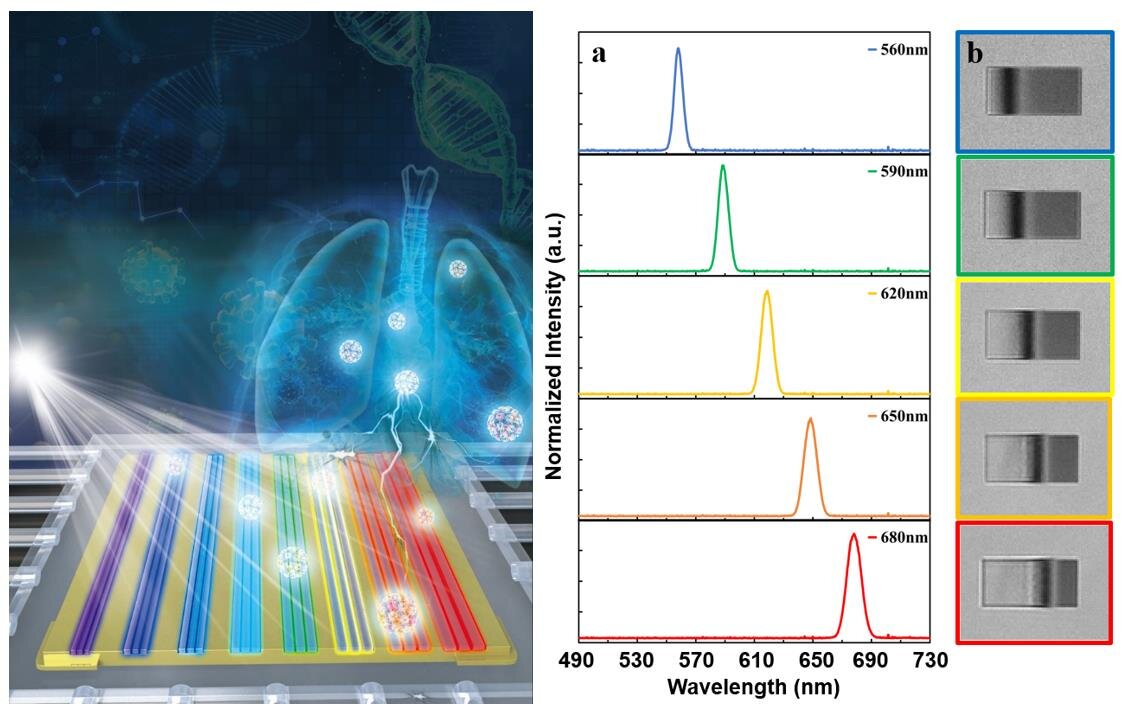Schematic diagram of the iris capture metasurface used in lung cancer diagnosis (left) and images of rainbow localization for spectral analysis observed with a 4× objective (right). Author: Qiaoqiang Gan
The global spread of COVID-19 has highlighted the importance of rapid, accurate and easy detection of viruses and diseases. Recently, researchers are exploring on-chip sensing technologies to address these emerging challenges. More and more health monitoring features are being integrated into wearable devices, including personalized sensors that can be used in everyday life.
New research led by engineers at the King Abdullah University of Science and Technology (KAUST, Saudi Arabia) and the State University of New York at Buffalo (University at Buffalo, USA) has made significant progress in this direction. The system is constructed from a graded nanolattice surface with a period change from 300 nm to 500 nm. When illuminated by LEDs or lasers, a dark band can be seen in the image display (as shown in the image).
The spatial location of the dark band is determined by the incident wavelength, that is, different incident wavelengths will result in different dark bands at different locations within an area of 30 μm × 64 μm (smaller than the cross-sectional area of a hair). That’s why this phenomenon is called “a rainbow“trap on a chip. When biomolecules bind to this chip, the location of the dark band will spatially shift, allowing direct observation of these surface bindings.
“Rainbow light trapping is an intriguing on-chip slow-light phenomenon first reported in 2007 based on negative-refractive-index metamaterials. However, to capture a true rainbow rather than a single wavelength, a broadband negative-refractive metamaterial is required. This type of material has not been implemented to date,” says Gan, the lead author of the paper, a professor at KAUST.
“My group demonstrated this fundamentally intriguing phenomenon using graded surface lattices and confirmed it experimentally. Now we’ve filled the app gap with the captured rainbow chip.
Importantly, a 0.032 nm wavelength shift was observed when using a 4× microscope (a low setting that can easily be implemented with a toy microscope and a handheld cell phone microscope), indicating the feasibility of spectroscopic analysis using this miniaturized chip, which is equivalent to performance of conventional expensive fiber or diffraction grating benchtop spectrometers.
This team prepared 2 × 2 rainbow sensor arrays on the same chip and performed high-throughput sensing of exosomal epidermal growth factor receptor (EGFR), a promising circulating biomarker for lung cancer diagnosis.
“The most attractive feature is that the sensitive sensing was realized using a low-cost optical microscope system,” says another lead co-author, Dr. Yoon Wu, associate professor of biomedical engineering at the University of Buffalo. “The sensing results distinguish lung cancer patients from healthy controls, which is equivalent to conventional methods. But our current rainbow chip system is much simpler and more cost-effective, and can be integrated with future smartphone systems.”
The study was published in Engineering.
Liu Zhou et al., Super-Resolution Offset Spectroscopic Sensing over the Rainbow Surface, Engineering (2022). DOI: 10.1016/j.eng.2022.03.018
Citation: Optical biosensing through a toy microscope over a ‘rainbow’ surface chip (October 3, 2022), Retrieved October 3, 2022, from https://phys.org/news/2022-10-optical-biosensing-toy-microscope-surface .html
This document is subject to copyright. Except in good faith for the purpose of private study or research, no part may be reproduced without written permission. The content is provided for informational purposes only.








